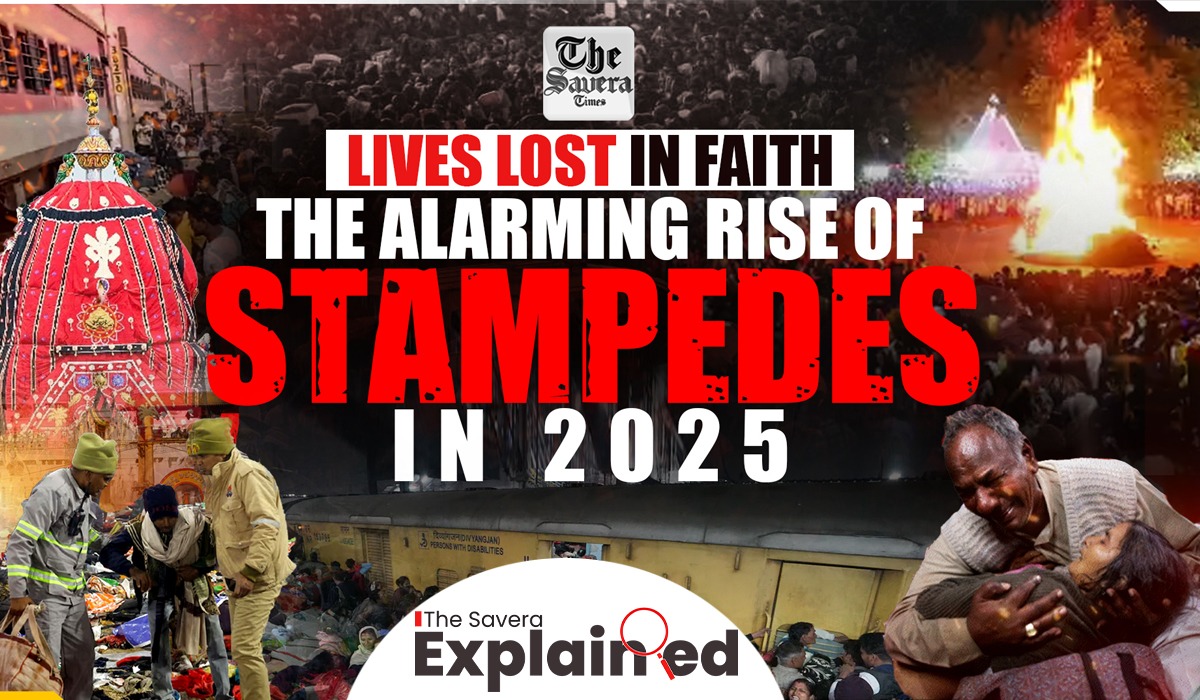The year 2025 began not with celebration but with a series of devastating stampedes at religious gatherings across India, plunging countless families into grief.
These tragic incidents, occurring at sacred events from the Jagannath Yatra in Odisha to the Maha Kumbh in Uttar Pradesh, and stampedes in Delhi and Goa, many have lost their lives and thousands have been injured, indicating a series of security and crowd management lapses at such crucial religious gatherings.
Here’s a list of deadly stampedes in 2025, highlighting their causes, impacts, and the urgent need for reform.
- Jagannath Yatra Stampede, Puri, Odisha:
The latest tragedy occurred on Sunday during the Jagannath Yatra in Puri, Odisha. As thousands of devotees gathered near the Gundi Cha Temple to witness the mesmerising chariot procession, a sudden surge in crowds led to a stampede.
According to the reports, three devotees have lost their lives, and more than three dozen have been injured. Odisha Chief Minister Mohan Charan Majhi called it an “unforgivable lapse”. Additionally, he has suspended the Puri DCP Bishnu Charan Pati and Police Commandant Ajay Padhi.
Former Odisha Chief Minister Naveen Patnaik, while extending condolences to the families of the devotees who died, lashed out at the government and called this stampede – “a failure of crowd management” that “exposes the government’s glaring incompetence in ensuring a peaceful festival of devotees.”
Former CM Naveen Patnaik criticized the government’s “glaring incompetence.” The incident intensified debates over accountability and the need for robust safety protocols at major festivals like the Rath Yatra, adding to 2025’s toll of religious tragedies.
- Maha Kumbh Mela Stampede, Prayagraj, Uttar Pradesh:
The Maha Kumbh Mela, the world’s largest religious gathering, turned catastrophic on January 29 during the Mauni Amavasya holy dip in Prayagraj.
- Incident Details: A crowd crush erupted near barricades at the Sangam—the confluence of the Ganges, Yamuna, and mythical Saraswati rivers—as millions converged for the sacred ritual. The chaos unfolded between 1 am and 2 am, with devotees overwhelming security measures.
- Casualties: At least 36 confirmed deaths and over 60 injuries were reported, though independent sources, including a BBC News Hindi report, suggest up to 82 fatalities, with a Newslaundry investigation citing 79 based on hospital and police records.
- Causes: Inadequate crowd control, narrow pathways, and a collapsed barrier triggered the crush. An estimated 100 million pilgrims attended that day, far exceeding planned capacity.
- Response: Uttar Pradesh CM Yogi Adityanath called the incident “heart-wrenching,” ordering a judicial probe led by Justice Harsh Kumar. The Amrit Snan ritual was temporarily halted, and a helpline (1920) was issued. Critics, including Swami Avimukteshwaranand Saraswati, accused the government of downplaying the toll and prioritizing VIP protocols.
- Implications: The tragedy highlighted systemic failures in managing massive crowds, despite 50,000 security personnel and extensive surveillance. A Supreme Court petition demanded stricter safety guidelines.
- New Delhi Railway Station Stampede, Delhi:
On February 14, a deadly stampede at New Delhi Railway Station underscored the ripple effects of mass pilgrimages on transportation hubs.
- Incident Details: The stampede occurred on a narrow footbridge connecting platforms 14 and 15, triggered by sudden platform changes and overcrowding. Many victims were pilgrims traveling to the Maha Kumbh Mela.
- Casualties: At least 18 lives were lost, including women and children (three girls aged 7, 8, and 15, and others aged 24 to 70), with nearly two dozen injured.
- Causes: Over 49,000 general tickets were sold that day—13,000 above the daily average—overwhelming infrastructure. Confusion between the Prayagraj Express and Prayagraj Special trains, coupled with delayed eastbound trains, led to chaos.
- Response: Union Railways Minister Ashwini Vaishnaw ordered a high-level inquiry and introduced four special trains to ease the rush. Opposition leaders, including Congress president Mallikarjun Kharge, criticized the government for inadequate arrangements and lack of transparency.
- Implications: The tragedy exposed poor railway safety measures during peak religious travel, prompting calls for better crowd control and infrastructure upgrades.
- Lairai Jatra Festival Stampede, Shirgao, North Goa:
The Lairai Jatra festival in Shirgao village, North Goa, became a site of tragedy on May 3, highlighting risks at smaller religious gatherings.
- Incident Details: A stampede in the narrow lanes around the Lairai Devi Temple occurred as thousands gathered to honor the deity, with panic erupting due to congested pathways.
- Casualties: Six people were killed, and up to 100 were injured. Some reports cite seven deaths and 80 injuries.
- Causes: Limited entry and exit points, insufficient security, and overcrowding in confined lanes triggered the surge. The rural temple’s infrastructure was ill-equipped for the crowd.
- Response: The incident sparked public outrage, with locals and officials demanding stricter safety regulations for religious festivals.
- Implications: The tragedy underscored the need for modernized crowd control at smaller, rural religious sites, where infrastructure often lags behind urban centers.
These four incidents have reignited public debate over India’s ability to manage massive religious events safely. The National Disaster Management Authority’s guidelines, such as pre-registered passes and staggered timings, are often poorly implemented.
These tragedies demand urgent reforms, including modernized infrastructure, enhanced security, and stringent safety audits to ensure faith is not marred by loss.

